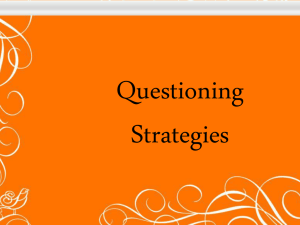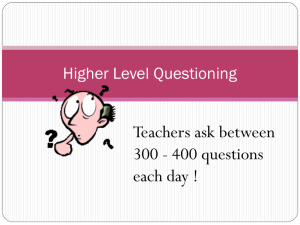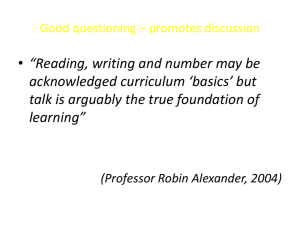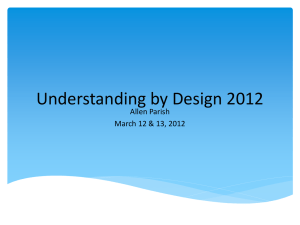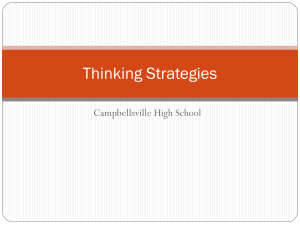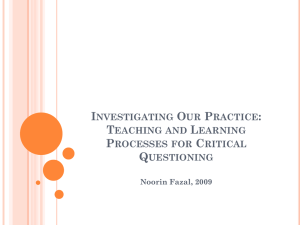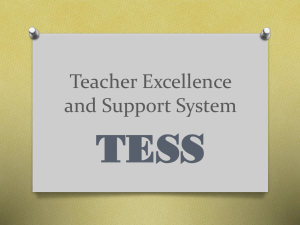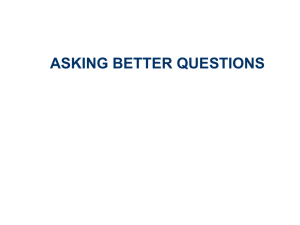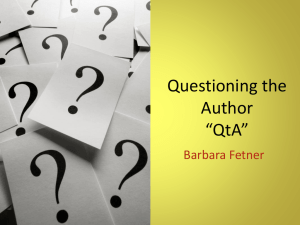TheSuperheroArtofQuestioning
advertisement
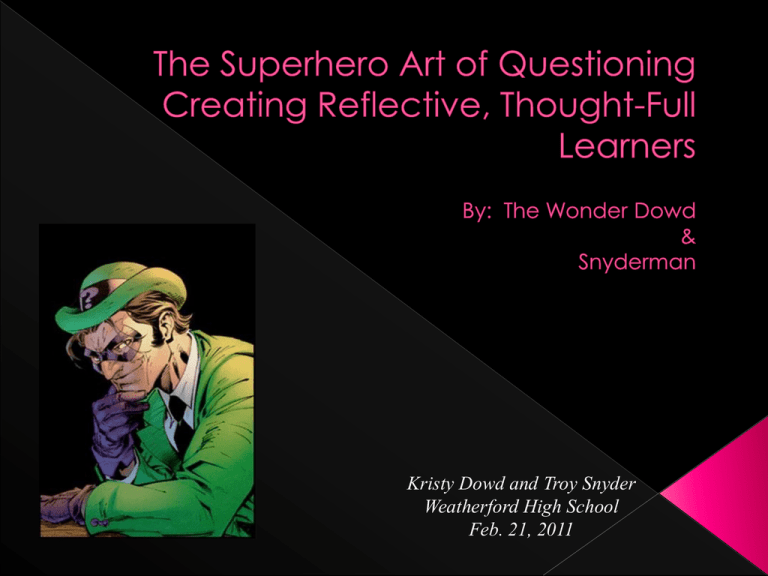
Kristy Dowd and Troy Snyder Weatherford High School Feb. 21, 2011 “Questions, not answers are at the heart of education” (Dennis Duncan, teacher). “I have no answers, only questions” (Socrates c. 300 BC). “An unanswered question is a fine travelling companion. It sharpens your eye for the road” (Rachel Naomi Remen, M.D.). As An Instructional Tool? As an Assessment Tool? Research states that effective questioning strategies have a positive impact on overall student achievement. Knowing how to think to extend the mind beyond the obvious and develop creative solutions to problems should be the outcome of a good education. Our thinking skills affect how well we can receive and process new information. “To question well is to teach well” (Wilen, 1991) North American children fall short in this critical skill. Studies show that teachers ask students limiting questions. Research reports that 75 to 80 percent of the questions posed in elementary and secondary classrooms are at the recall level or memory level. Teachers say that they teach by asking questions but they can’t describe the types of questions that they ask. Teachers frequently say that all questions have merit but that’s not the case with teacher questions. The content of the question and the manner in which teachers ask them determines whether or not they are effective. Contributes to learning Sparks further questions and interest in seeking answers Involves critical and creative thinking Goes beyond recall of basic information Provides challenge but is not too threatening Is appropriate to the learning situation and the student Builds on prior knowledge and makes connections Involves students in reflection and/or planning The purpose of critical thinking is to achieve understanding, evaluate view points, and solve problems. Since all three areas involve the asking of questions, we can say that critical thinking is the questioning or inquiry we engage in when we seek to understand, evaluate or resolve. Critical thinkers: distinguish between fact and opinion; ask questions; make detailed observations; uncover assumptions and define their terms; and make assertions based on sound logic and solid evidence. Maybe the question should be “Can children be taught to think more effectively?” A skilfully orchestrated question and answer session causes a chain effect, in which, the instructor and students can journey from simple factual inquiries to an insightful exchange of information, ideas and realizations. As an instructor’s ability to engage the learner, and incorporate questioning techniques into the classroom increases, so will the opportunity of teachable moments. The griney grollers grangled in the granchy gak. What kind of grollers were they? 2. What did the grollers do? 3. Where did they do it? 4. In what kind of gak did they grangle? 5. In one sentence, explain why-the grollers were grangling in the granchy gak. 6. If you had to grangle in a granchy gak, what one item would you choose to have with you and why? 1. Students can answer low-level questions without thinking. Students enter/exit classrooms with no more understanding of what they’ve learned than “The Griney Groller” taught you! QUILT – questioning and understanding to improve learning and thinking. This program was developed to enhance student learning by improving teachers’ classroom questioning techniques. During 1991-92, the QUILT program was classroom tested in 13 school districts with more than 1,200 teachers. The QUILT program claims to show an increase in teacher understanding of effective classroom questioning and a corresponding use of effective questioning practices along with an increase in student thinking. QUILT is on PD 360. (Elementary and Secondary versions) Stage 1: Preparing the question: Identify the instructional purpose › Recitation vs. Discussion Determine content focus › Worth being familiar › important to know and do › Enduring Understanding Select cognitive level › Bloom’s Taxonomy: Higher level ≠ Better › Critical Thinking Strategies Guide › Cognitive level of question and cognitive level of Student Response › Considerations - Developmental level of students, Prior Knowledge Select wording and context › Clear , simple, Appropriate › No double barrelled question. Closed Questions: › typically begin with do, is, can, could, will, would, shall or should and usually have only one response. Used to recall information and assess the prior and post activity knowledge of the students. Recitation. Open Ended Questions: › usually begins with who, what, when, where, or how. › useful to stimulate group discussion. › may be many different responses. Higher Level Questions › require students to work out answers rather than memorize them. › give the student a license to explore the possibilities. › Bloom categorizes higher level questions into three categories: analysis, synthesis and evaluation. › encourage students to think more deeply and critically, to problem solve, inspire discussions and stimulate students to seek information on their own. Here is an example of questions used with a simple source, the nursery rhyme Little Boy Blue, during a Primary environmental study. Little Boy Blue, come blow your horn, The sheep’s in the meadow, the cow’s in the corn, Where is the boy who looks after the sheep? He’s under the haystack, fast asleep. Knowledge (Remembering): In this picture, what is the color of the boy’s coat? Comprehension (Understanding): Can you describe his coat in your own words? Application (Solving): Do you know someone like Little Boy Blue? Analysis (Reasoning): Why might he have fallen asleep? Synthesis (Creating): How he will explain to the farmer how the cow got into the corn? Evaluation (Judging): Why does it matter if he falls asleep if no one ever finds out? Stage 2: Presenting the question: Indicate response format Ask the question Select respondent › How do students respond (orally, written, both? › How do they signal their responses? › Do students understand the format? › Are students actively listening? › Do students understand the question? › › › › › Who? Cooperative responses? Do all students have equal opportunities? Are questions directed or undirected? Are respondents designated ahead of time? Are high and low achievers selected equally to answer equally difficult questions? Supply Your Bat Belt Stage 3: Prompt student responses: Pause after asking question › Wait Time I – length of time a teacher pauses after asking a question Assist non respondent › Use lower level questions to prompt › Connection Association › Notify students ahead of time Pause following student response › Wait time II – the time a teacher waits after a pupil’s response after to either comment or ask another question Stage 4: Responding to student responses: Provide appropriate feedback › How do you react? Positive, appropriate, provide students opportunities to correct own mistakes, leave all students with correct answer. Expand and use correct responses › Do students expand on correct answers? Are they amplified, reused in the lesson, are questions redirected for alternate answers Elicit student reactions and questions › Do students create questions? What is your classroom climate? Stage 5: Critiquing the questioning period: Analyze the questions › How do you access your own question, align your questions with your objective, what kind of questions did students respond... Map respondent selection › How where they selected, demographics, what format did they respond to.... Evaluate student response patterns › How complete were responses, was wait I and II time used... Examine teacher and student reactions. › What type of feedback was given, were responses expanded on, did students initiate questions... Reasons for students to develop their own questions: Increases motivation to learn Improves comprehension and retention Encourages creativity and innovation Teaches how to think and learn Provides a basis for problem solving and decision making. I wonder…? 1. Pose the question first, before asking the student to respond. 2. Allow plenty of think time by waiting at least 3 5seconds. 3. Make sure you give all students the opportunity to respond rather than relying on volunteers. Create a system to help you keep track of who you call on. 4. Hold students accountable by expecting and facilitating their participation and contributions. 5. Never answer your own questions. Do not accept “I Don’t Know”. Establish a safe environment After asking the question, the instructor would remove himself from the center of attention. › pause after a question. › direct correlation between pause time and quality of the response. › Higher level questions require time for students to formulate answers. Longer response time will foster a climate for students to become critical thinkers. When a student asks the instructor a question the instructor should redirect the question to the class. Let’s compare these two pictures. (instead of look) What do you predict will happen when…? (instead of think) How can you classify? (instead of group) Let’s analyze this problem. (instead of work this problem) What conclusions can you draw? (instead of what did you think) Indicators that Instructional Methods Are Paying Off: Persistence Decreasing Impulsivity Listening to Others with Understanding and Empathy Flexibility in Thinking Learners are active and in continuous dialogue with teacher Learning is constructing, not feeding Truth is discovered, not delivered Teacher “leads from behind” Teacher functions as facilitator/mentor instead of lecturer Questions are answered with explanations or questions, not simply “yes or no” Questions rarely have one right answer Pertinent discussions on related issues often break out Debate is common Peers exchange ideas Learner and teacher satisfaction increases Teachers often face questions for which there are no answers Social interaction and acceptance in the class is generally high Math › What are the attributes of______? › How would you describe_____to a friend? › How can you illustrate________? › How can you sort___________? › Combine several strategies and show how you would solve__________? › How do we know we have found the correct answer? Science › Define______. › Describe what _________looks like. › Why does ________ work? › Predict what you think will happen. › Design a new way to___________. › What would happen if you skipped a step in the experiment? › What is the result of this investigation? Brainstorming Fluency Flexibility Originality Elaboration White Hat (information/facts) Green Hat (creation/ new ideas/ alternatives) Yellow Hat (positives/benefits/ advantages) Black Hat (judgements/disadvanatges/ risks) Red Hat ( emotions/feelings) Blue Hat (organization of thinking) All The Best In Your Planning! Beers, Kylene, (2003) When Kids Can’t Read: What Teachers Can Do. Portsmouth, NH: Heinemann Publishers. Brualdi, Amy, (1998) Classroom Questions. ERIC Clearinghouse on Assessment and Catholic University of America, Shriver Laboratory, College Park, MD. Evaluation, The www.ericfacility.net/ericdigests/ed422407.html Cotton, Kathleen, (2001). Classroom Questioning. Northwest Regional Educational Laboratory. www.nwrel.org/scpd.sirs/3/cu5/html Cotton, Kathleen, (2001). Teaching Questioning Skills: Franklin Elementary School. Northwest Regional Educational Laboratory. www.nwrel.org/scpd/sirs/4/snap13.html De Bono, Edward (1999). Six thinking hats. New York: Little, Brown , and Company. Harvey, S., and Goudvis, A. (2000). Strategies That Work: Teaching Comprehension to Enhance Understanding. York, ME: Stenhouse Publishers. Heffernan, Lee, (2004). Critical Literacy and Writer’s Workshop. Bloomington, INDIANA: International Reading Association. McLaughlin, M., and DeVoogd, G., (2004) Critical Literacy: Enhancing Students’ Comprehension of Text. New York, NY: Scholastic. Mittelstaedt, M. (1991) A Research Proposal for a Study to Support That an Early Childhood Teacher’s Perception of the Importance of Higher Cognitive Questioning Techniques Impacts the Implementation of the Questioning Techniques Done in the Classroom. Phi Delta Kappa Educational Foundation. Morgan, N., and Saxton, J., ((1994). Asking Better Questions. Markham, ON: Pembroke Publishers. Muth, Jon, ((2002). The Three Questions. New York, NY: Scholastic Press. Schwartz, S., and Bone, M. (1995). Retelling, Relating, Reflecting: Beyond the 3R’s. Toronto, ON: Irwin Publishing. Urbanoski, Janice, (2000). The Role of Questioning Techniques in the Classroom. www.instructordiploma.com/core/102%20B/jan.htm Van Allsburg, Chris, ((1984). The Mysteries of Harris Burdick. Boston, MA: Houghton Mifflin Publishing. Wolf, Dennis Palmer, (1987). The Art of Questioning. Academic Connections, 1-7, www.exploratorium.edu/IFI/resources/artofquestioning.html

